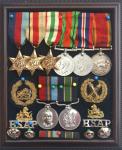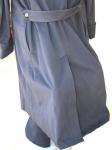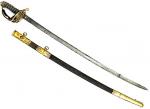-
Posts
13,225 -
Joined
-
Last visited
-
Days Won
22
Content Type
Profiles
Forums
Blogs
Gallery
Events
Store
Everything posted by Mervyn Mitton
-
-
-
Hello Volvo - welcome to the Forum. I am attaching some variations on the Mk.1 Fairburn Sykes fighting knife. They should help in your identification. If the prices show - ignore them - they are from a 1985 ref. book. You are looking at a high price for a genuine mk.1 - which came in two patterns.
-

The Welsh Guards
Mervyn Mitton replied to leigh kitchen's topic in Great Britain: Militaria: Badges, Uniforms & Equipment
This should be good thread, Leigh. I shall look forward to seeing you enlarge on their history. -
Alec - another series of exceptional old photographs. The European powers were there to try and save lives - but, what a savage and inhospitable place. Amazing the difference 114 years can make - package tourists wouldn't have wanted this old version .... I am sure all of the pictures are of great interest to an historian - clothes,weapons, foods etc.. However, there are four that I would like to make comment-on. No.19 Firing the salute. Surely they would have been safer firing directly ahead ? No.14 More seriously, this is interesting in that it shows senior naval officers still wearing frock coats. The caps would have been of the pattern with a narrower crown - pity the sun has caught the white cover. Also, see how high the medal ribbons bars are being worn. No.23 Regimental march past. Note the 4 Pioneers in front of the Colonel on horseback. Two are carrying axes and two - spades. No.25 The salute by naval ships - presumably from different Navies ? 1897 still had the old pre-Dreadnought battleships in action - most are two funnel ships, with early type destroyers in front. The bigger ships behind could be cruisers. This really is going back in time.
-
Fascinating history Arthur - and links to an important German family. I note that one name includes the word Graf. I always understood that stood for a Duke in German ? Perhaps they have a family link to one ? You rightly point out that the mystery is whose uniform is he wearing ? Only the buttons might give a hint - but, even on enlargement I can't make out any details ?
-
We seem to have been quiet on our Police Forum for a while - I am particularly sorry to see Brian's 'Special Constabulary' sub-forum lapsing. There is not a lot of available ref. material for Specials and with 10,000 posts and so much information it has become a valuable resource for anyone interested in the subject. I started in July 2010 (Goodness ! How time flies by.) a few posts on old uniforms that I have in my collection. I held back on the Dress Uniform for a senior officer of the Metropolitan Police in case Nick needed it for the proposed new Police Forum - however, I think he is under such pressure that it is on the 'back burner' for the present. The Metropolitan Police - being the first civilian Police Force in the World - have always been a 'law unto themselves' with regard to uniforms, customs and officer ranks. The term Commissioner was first used by Sir Robert Peel - when as Home Secretary - he supervised their establishment. He appointed two men as joint commissioners. Eventually this was changed to one man and under him was a Deputy Commissioner. Later 4 Assistant Commissioners were set-up to supervise different sections of the Force. One day I will do a short article on all of the different rank structures that have existed over the last 180 years - meanwhile, I will just say that in modern terms the Commissioner is the equivalent of a full general. the Deputy Comm. - a Lieutenant Gen. and the Asst. Comms. - Major Generals. (The Met. - Police and civilians - is nearly 60,000 - so he commands the equivalent of 1/3 rd. of the British Army ! God help us - could we even defend ourselves against Iceland ?) This full dress uniform and horse cloak is for an Asst. Comm. - the last man who wore it retired in about 1970/80 and gave it as a gift to his 'dresser' - the term used for the retired police officers who act as servants for the very senior ranks. I think his name may have been Vine - but I have had it for a long time. A full uniform for a senior officer is a very expensive item and they were handed down - not discarded. I think this one was given to the dresser as they were being discontinued. I can see styles and details in the uniform, that probably take it back to pre-1920. But, if I can't remember his name I don't suppose we will ever know ! Asst. Comms. wore a Bi-corne hat with swan's feathers . For this rank they are quite short - longer for the Comm. The tunic has 'Austrian' frogging and you will note that his badge of rank is crossed tipstaffs in a wreath. This is now for a Commander and the Asst. Comm.a star above the wreath. The trousers have a band of embroidered silk along their outer sides. The horse cloak spreads out to cover the rear (withers) of the horse. It is red silk lined and is very heavy. Remember that he would have worn a silver belt - carried a sword and the horse blanket was embroidered with his rank and the Coat-of-arms. Rather dull compared with military uniforms - never-the-less it is an impressive outfit. Rare these days to be so complete.
-
Officers' at this time commonly carried a stick for authority - and no doubt to help on rough ground. Most had a sword concealed inside for quick defence. Sometimes the blade used was from an old Levee sword - these are dress swords to be worn in the presence of the King - or, his representitive and have a thin blade. The alternative was to use a blade from an earlier sword - and then , of course, it was a heavier weapon - capable of doing more damage. The sword stick illustrated here is from about 1810 and has the lighter blade. You can still buy them in specialised shops - however, their use is prohibited in most Countries. Summing-up - an officer at this time carried a pistol - wore a sword - and, may have also carried a sword stick. When the fighting was really bad, most officers would make use of a rifle as well.
-
Sorry for the delay in finishing the weapons carried by officers'. (They say as you get older 'time passes faster' - they're right !) The pattern of sword carried by officers' was the 1845 - but, modified in 1854 when the folding guard was made as one piece. It was a single edged weapon, with a fullered (shaped areas on either side of the blade to lighten the weight) blade. Basically - with it's sharp point it was a thrusting weapon and the edge was not sharpened - although with force it could be dangerous.
-
Hi Shams. Very nice to know a little about you - when do you expect to go to Canada for your Doctorate ? You will have plenty of our members to contact. The illustrations you sent were exceptional - in one of them the officer is wearing the 1912 pattern cavalry sword - so, it matches the porcelain figure. Thankyou.
-

Royal Artillery Band Helmet.
Mervyn Mitton replied to Brian's topic in Great Britain: Militaria: Badges, Uniforms & Equipment
Simon - it looks to have a leather type finish ? I suppose it might have been adapted from a Police helmet - but a lot of work with the four brass straps. They did make experimental styles to be submitted to different Boards - perhaps Brian is right and it is such a helmet. Would be valuable if the Artillery link can be proved. -
GOOGLE - ' Queen Victoria's Funeral - order of procession'. Lots of good info. and pictures - incl. at no. 4 our thread ! I found separately the list of VIP's in the Procession - although not their exact places. However - these can be judged from the order of precedence. The Duke of Connaught was in the first row with King Edward and the Kaiser. He was the senior Royal Duke and the Uncle of the Queen. Sovereigns present : King Edward 7th.; Kaiser Wilhelm 2nd.; King George of the Hellenes (Greece); King Carlos of Portugal ; King Leopold of the Belgians. The Crown Princes of : Germany ; Rumania; Greece; Denmark; Norway; Sweden; Siam (Thailand). + The Arch Duke Franz Ferdinand (Austria Hungarian Empire); Grand Duke Michael Alexandrovitch (Russia); Duke of Aosta (Italy). This should help a little - unfortunately, they all look the same - arrogant and pompous and overdressed !
-
You're right, Simon. Chris has turned up wonderful info. on a S.A. resident - and the brother of a Count ! In the UK that would be an Earl.















